SRTM DEM Correction in Vegetated Mountain Areas through the Integration of Spaceborne LiDAR, Airborne LiDAR, and Optical Imagery
Abstract
:1. Introduction
2. Study Area and Datasets
| Name | Type | Time | Coverage | Resolution | Source |
|---|---|---|---|---|---|
| Forest inventory | Field measurements | 2004–2009 | -- | -- | U.S. Forest Service |
| SRTM DEM | Imagery | 2000 | 5022 km2 | 30 m | U.S. Geological Survey |
| GLAS/ICESat | Full-waveform LiDAR | 2003–2009 | -- | ~65 m in diameter | NASA |
| Airborne LiDAR | Discrete LiDAR | 2009 | 257 km2 | 15–20 cm in diameter | U.S. Forest Service |
| Aerial imagery | Imagery | 2009 | 5022 km2 | 1 m | U.S. Department of Agriculture |
| Landsat TM | Imagery | 2009 | 5022 km2 | 30 m | U.S. Geological Survey |
| Climate surfaces | Imagery | 1950–2000 | 5022 km2 | 30 m | Alvarez et al., (2014) [37] |
2.1. Study Area

2.2. In-Situ Data
2.3. SRTM Data
2.4. Spaceborne LiDAR Data
2.5. Airborne LiDAR Data
2.6. Aerial Imagery
2.7. Landsat TM Imagery
2.8. Climate Surfaces
3. Methodology
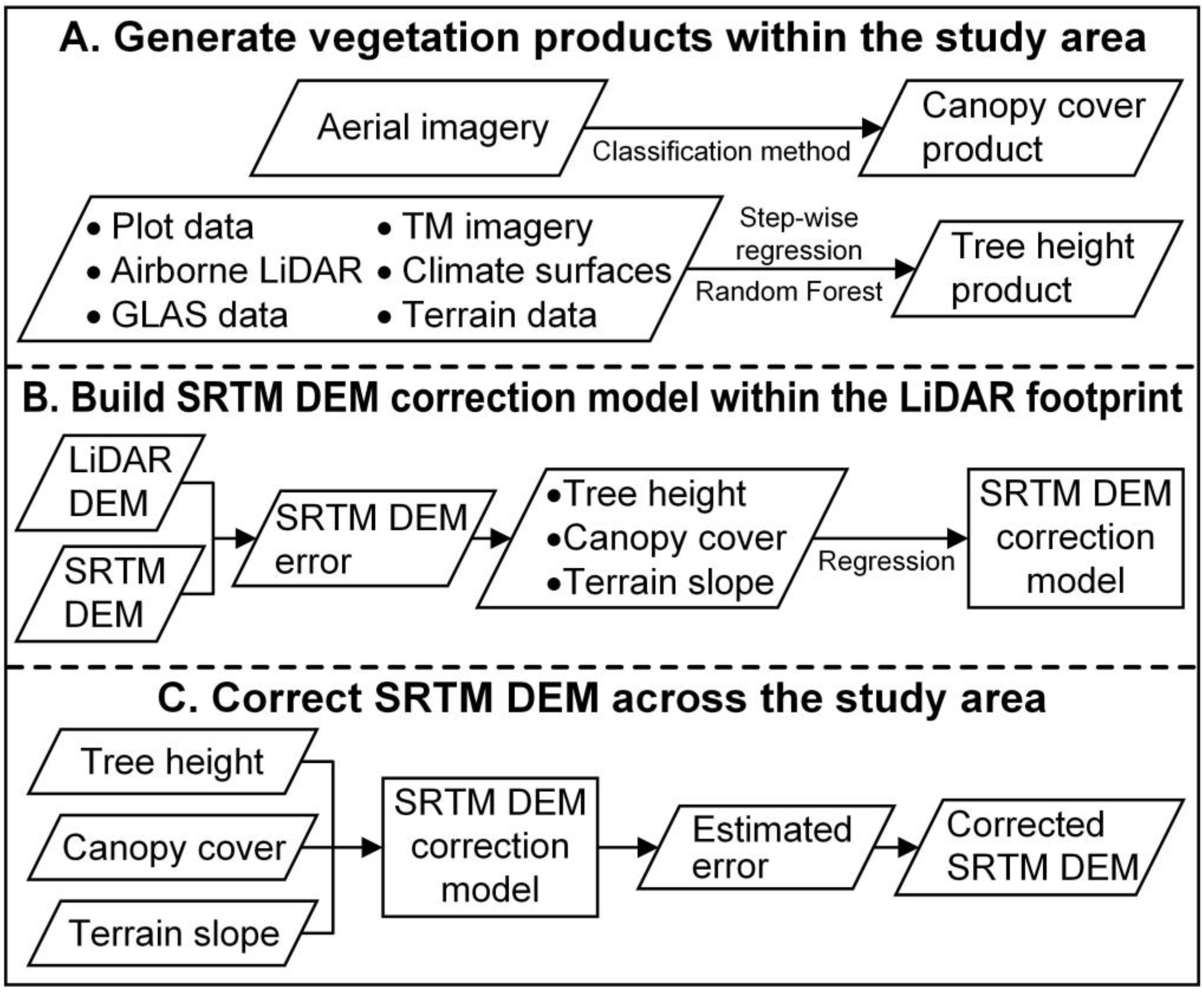
3.1. Canopy Cover Estimation Procedure
3.2. Tree Height Estimation Method
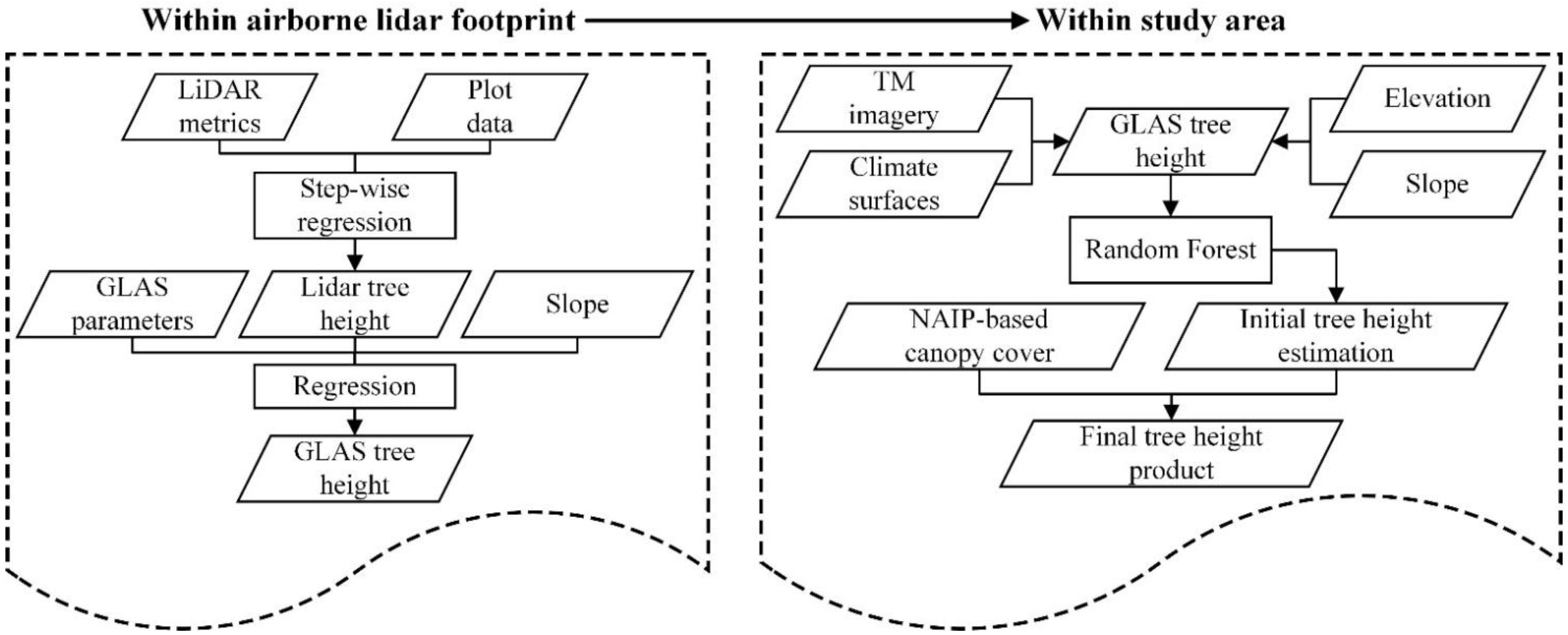
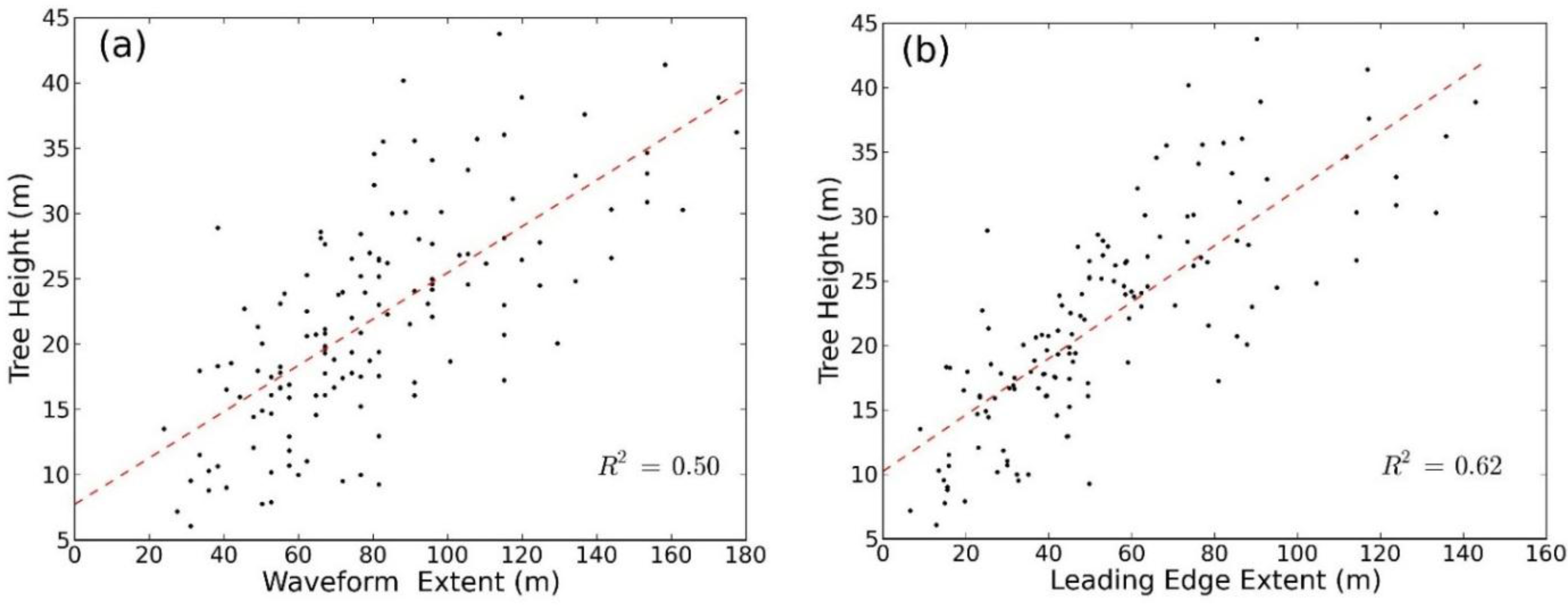
3.3. SRTM DEM Correction Method
3.4. Accuracy Assessment
4. Results
4.1. Canopy Cover Estimation
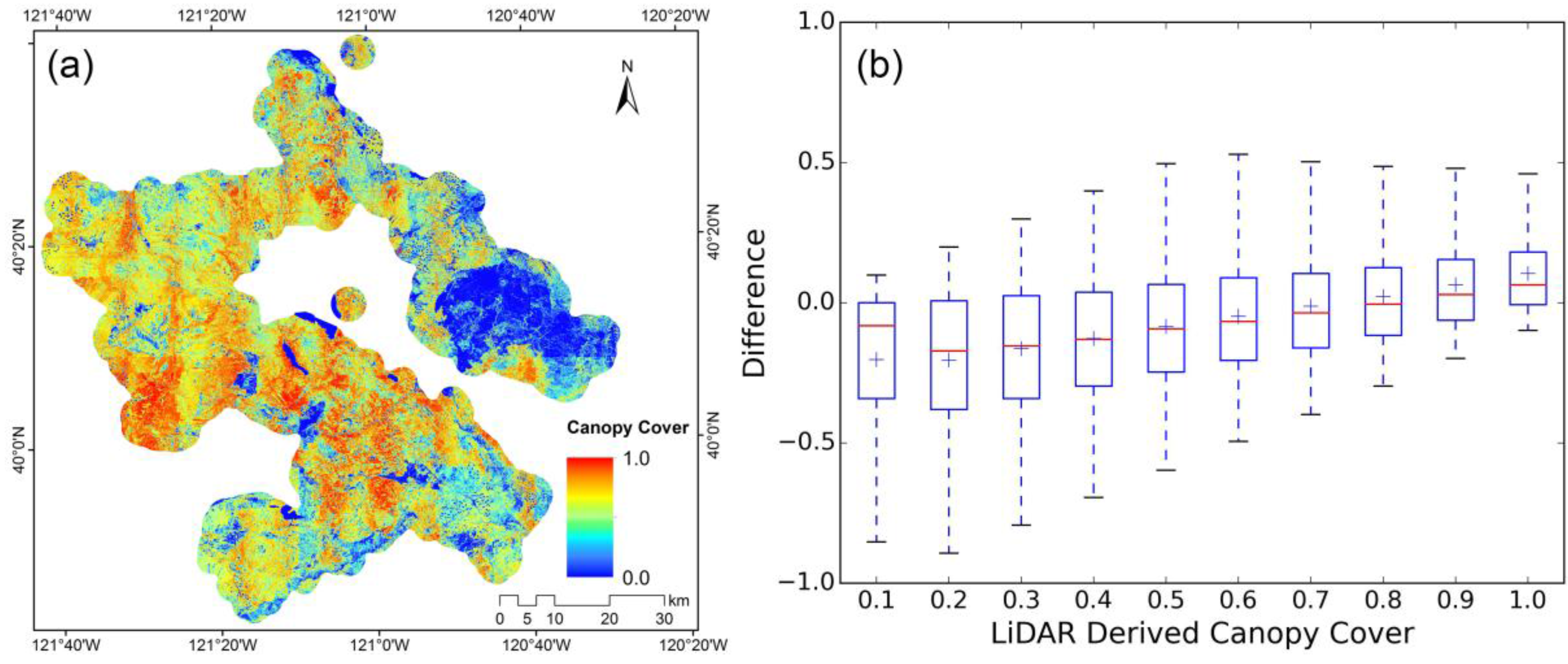
4.2. Tree Height Estimation
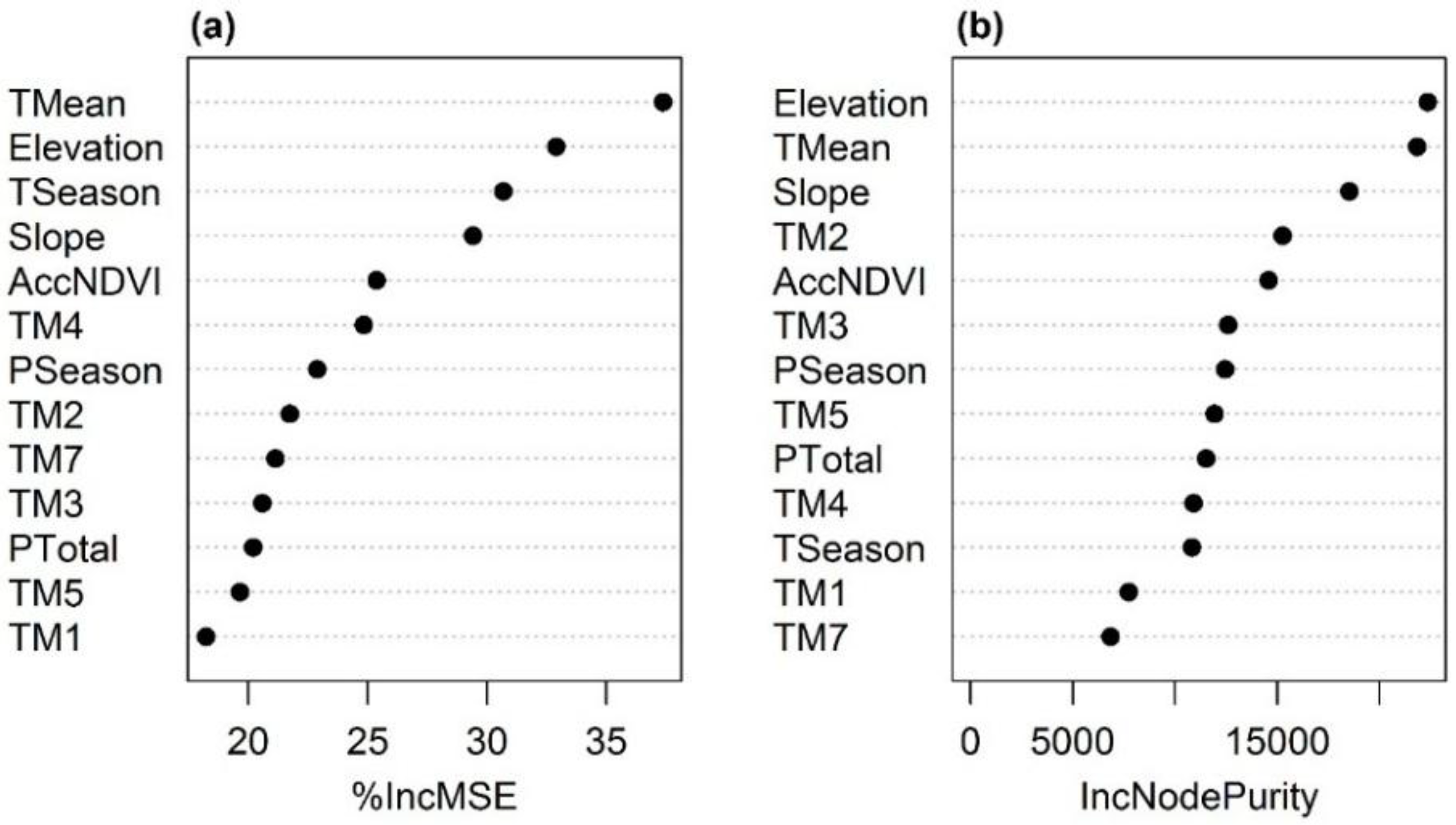
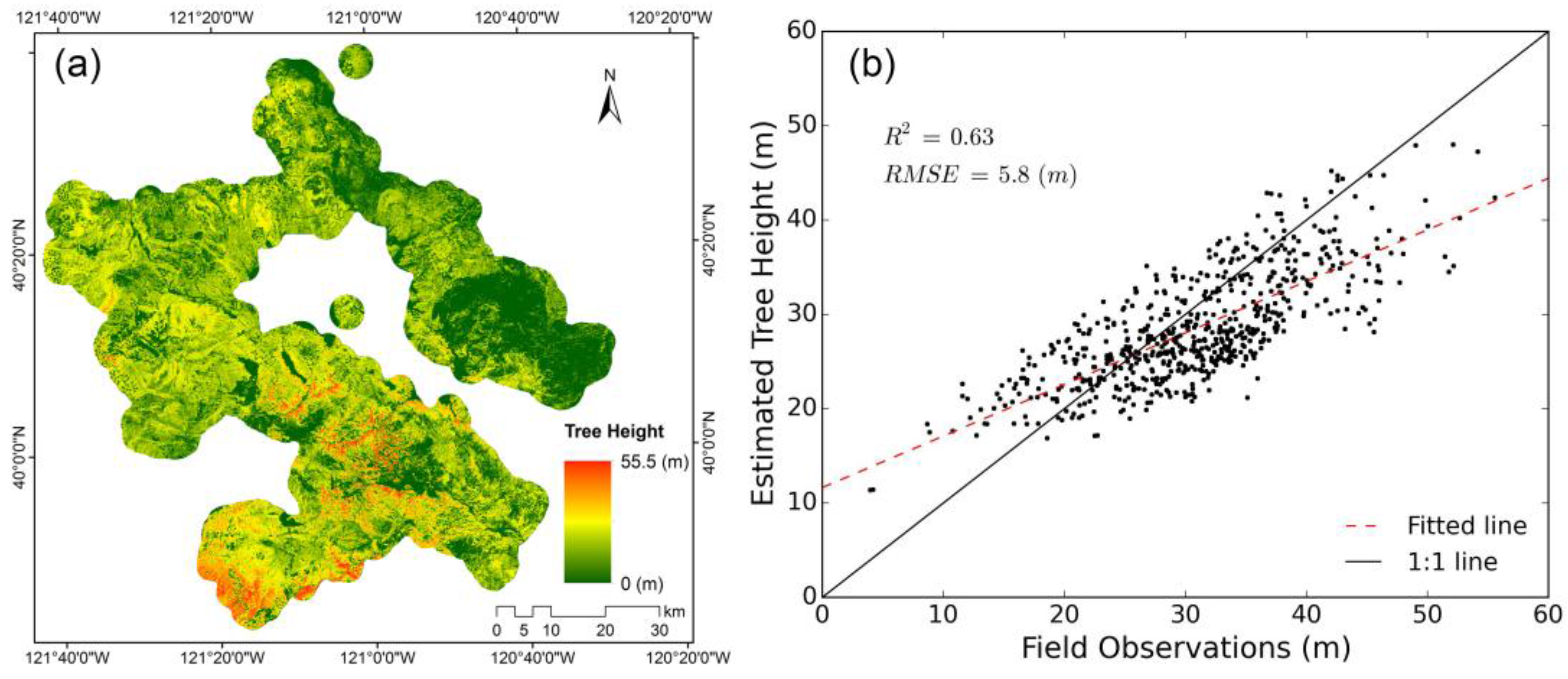
4.3. SRTM DEM Correction
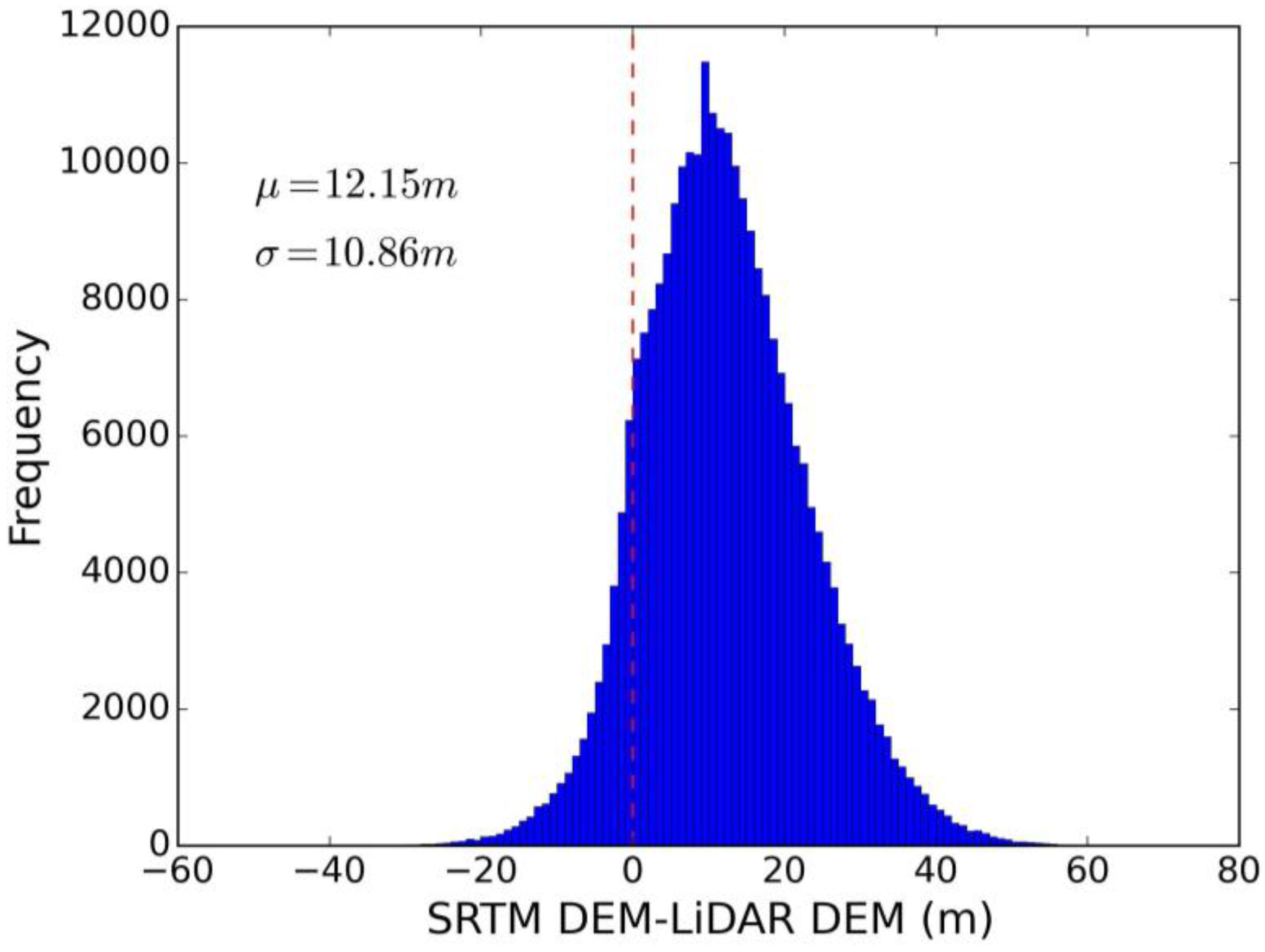
| Tree Height (m) | Canopy Cover (%) | Slope (°) | |||||||||
|---|---|---|---|---|---|---|---|---|---|---|---|
| Group | Mean a | STD b | N c | Group | Mean a | STD b | N c | Group | Mean a | STD b | N c |
| 0–5 | 3.04 | 7.39 | 34,387 | 0–10 | 2.11 | 7.68 | 15,482 | 0–5 | 9.52 | 8.07 | 43,494 |
| 5–10 | 6.01 | 8.17 | 13,952 | 10–25 | 4.57 | 9.06 | 15,438 | 5–10 | 12.12 | 8.43 | 69,034 |
| 10–20 | 7.91 | 8.71 | 40,121 | 25–50 | 7.21 | 8.89 | 44,492 | 10–20 | 12.72 | 10.66 | 111,021 |
| 20–30 | 13.33 | 9.95 | 139,790 | 50–75 | 11.76 | 9.58 | 87,439 | 20–30 | 13.12 | 14.35 | 41,927 |
| 30–40 | 20.67 | 10.30 | 42,986 | 75–90 | 15.15 | 10.19 | 65,838 | 30–40 | 12.80 | 18.20 | 7783 |
| ≥40 | 24.35 | 10.12 | 2751 | 90–100 | 19.29 | 10.86 | 45,298 | ≥40 | 13.30 | 23.13 | 724 |
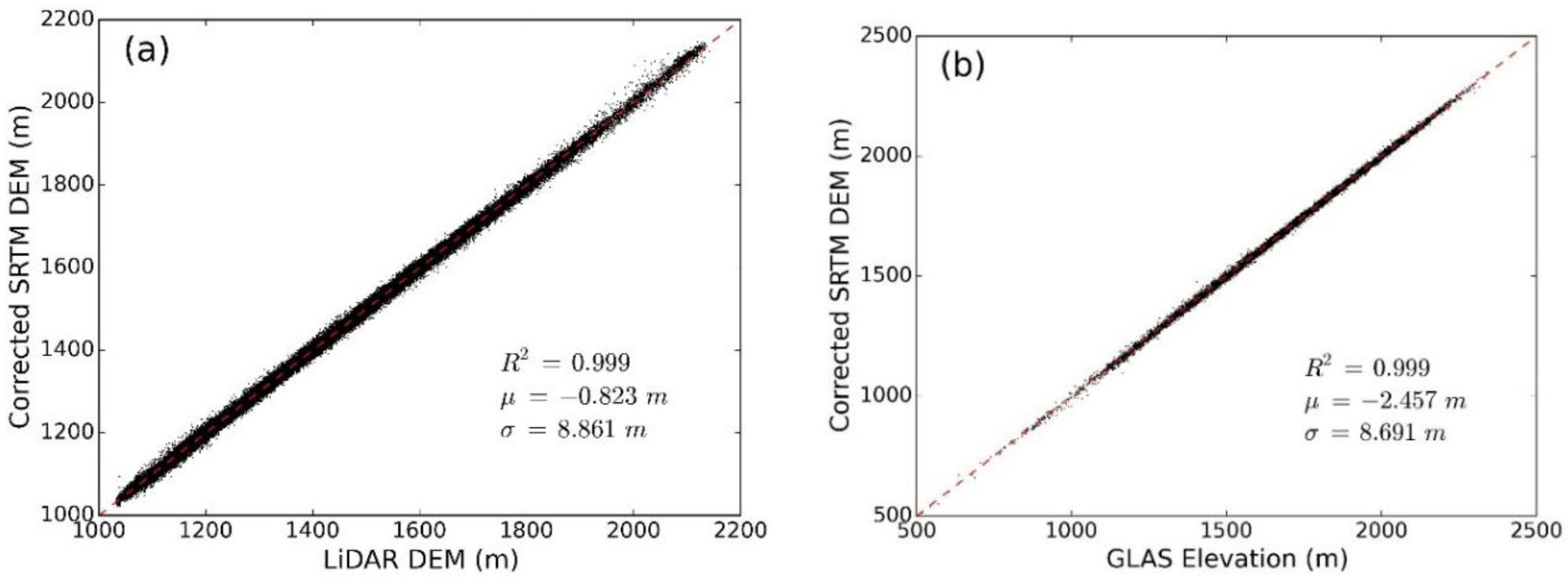
5. Discussions
5.1. Accuracy of Estimated Vegetation Parameters
5.2. Comparisons among SRTM DEM, GLAS Elevations, LiDAR DEM and Corrected SRTM DEM

| Tree Height (m) | Canopy Cover (%) | Slope (°) | |||||||||
|---|---|---|---|---|---|---|---|---|---|---|---|
| Group | Mean a | STD b | N c | Group | Mean a | STD b | N c | Group | Mean a | STD b | N c |
| 0–5 | −3.49 | 3.92 | 74 | 0–10 | −3.58 | 4.85 | 36 | 0–5 | −5.45 | 5.25 | 120 |
| 5–10 | −3.68 | 3.93 | 35 | 10–25 | −1.10 | 2.75 | 50 | 5–10 | −5.57 | 4.77 | 284 |
| 10–20 | −3.62 | 4.24 | 172 | 25–50 | −3.54 | 4.25 | 201 | 10–20 | −6.23 | 5.02 | 420 |
| 20–30 | −6.38 | 4.89 | 469 | 50–75 | −6.47 | 4.58 | 423 | 20–30 | −5.57 | 4.98 | 56 |
| ≥30 | −9.04 | 4.79 | 133 | ≥75 | −9.08 | 4.71 | 173 | ≥30 | −9.02 | 6.62 | 3 |
6. Conclusions
Acknowledgments
Author Contributions
Conflicts of Interest
References
- Zhang, W.; Montgomery, D.R. Digital elevation model grid size, landscape representation. Water Resour. Res. 1994. [Google Scholar] [CrossRef]
- Franklin, S.; Peddle, D.; Dechka, J.; Stenhouse, G. Evidential reasoning with Landsat TM, DEM and GIS data for landcover classification in support of grizzly bear habitat mapping. Int. J. Remote Sens. 2002, 23, 4633–4652. [Google Scholar] [CrossRef]
- Falorni, G.; Teles, V.; Vivoni, E.R.; Bras, R.L.; Amaratunga, K.S. Analysis and characterization of the vertical accuracy of digital elevation models from the shuttle radar topography mission. J. Geophys. Res. 2005. [Google Scholar] [CrossRef]
- Koch, A.; Lohmann, P. Quality Assessment and Validation of Digital Surface Models Derived from the Shuttle Radar Topography Mission (SRTM). Available online: http://www.ipi.uni-hannover.de/uploads/tx_tkpublikationen/Paper620.pdf (accessed on 9 July 2015).
- Callow, J.N.; van Niel, K.P.; Boggs, G.S. How does modifying a DEM to reflect known hydrology affect subsequent terrain analysis? J. Hydrol. 2007, 332, 30–39. [Google Scholar] [CrossRef]
- Peters, D.L.; Prowse, T.D.; Pietroniro, A.; Leconte, R. Flood hydrology of the Peace-Athabasca Delta, northern Canada. Hydrol. Process. 2006, 20, 4073–4096. [Google Scholar] [CrossRef]
- Ludwig, R.; Schneider, P. Validation of digital elevation models from SRTM X-SAR for applications in hydrologic modeling. ISPRS J. Photogramm. Remote Sens. 2006, 60, 339–358. [Google Scholar] [CrossRef]
- Van Niel, K.P.; Laffan, S.W.; Lees, B.G. Effect of error in the DEM on environmental variables for predictive vegetation modelling. J. Veg. Sci. 2004, 15, 747–756. [Google Scholar] [CrossRef]
- Drake, J.M.; Randin, C.; Guisan, A. Modelling ecological niches with support vector machines. J. Appl. Ecol. 2006, 43, 424–432. [Google Scholar] [CrossRef]
- Kellndorfer, J.; Walker, W.; Pierce, L.; Dobson, C.; Fites, J.A.; Hunsaker, C.; Vona, J.; Clutter, M. Vegetation height estimation from shuttle radar topography mission and national elevation datasets. Remote Sens. Environ. 2004, 93, 339–358. [Google Scholar] [CrossRef]
- Franklin, S.E. Remote Sensing for Sustainable Forest Management; CRC Press: Boca Raton, FL, USA, 2001. [Google Scholar]
- Steelman, T.A.; Maguire, L.A. Understanding participant perspectives: Q-methodology in national forest management. J. Policy Anal. Manag. 1999, 18, 361–388. [Google Scholar] [CrossRef]
- Farr, T.G.; Kobrick, M. Shuttle radar topography mission produces a wealth of data. Eos Trans. Am. Geophys. Union 2000, 81, 583–585. [Google Scholar] [CrossRef]
- Rabus, B.; Eineder, M.; Roth, A.; Bamler, R. The shuttle radar topography mission—A new class of digital elevation models acquired by spaceborne radar. ISPRS J. Photogramm. Remote Sens. 2003, 57, 241–262. [Google Scholar] [CrossRef]
- Rodriguez, E.; Morris, C.S.; Belz, J.E. A global assessment of the SRTM performance. Photogramm. Eng. Remote Sens. 2006, 72, 249–260. [Google Scholar] [CrossRef]
- Bourgine, B.; Baghdadi, N. Assessment of C-band SRTM DEM in a dense equatorial forest zone. CR Geosci. 2005, 337, 1225–1234. [Google Scholar] [CrossRef]
- Berthier, E.; Arnaud, Y.; Vincent, C.; Remy, F. Biases of SRTM in high-mountain areas: Implications for the monitoring of glacier volume changes. Geophys. Res. Lett. 2006, 33, L08502. [Google Scholar] [CrossRef]
- Weydahl, D.J.; Sagstuen, J.; Dick, O.B.; Ronning, H. SRTM DEM accuracy assessment over vegetated areas in Norway. Int. J. Remote Sens. 2007, 28, 3513–3527. [Google Scholar] [CrossRef]
- Leon, J.; Cohen, T. An improved bathymetric model for the modern and palaeo Lake Eyre. Geomorphology 2012, 173, 69–79. [Google Scholar] [CrossRef]
- Farr, T.G.; Rosen, P.A.; Caro, E.; Crippen, R.; Duren, R.; Hensley, S.; Kobrick, M.; Paller, M.; Rodriguez, E.; Roth, L.; et al. The shuttle radar topography mission. Rev. Geophys. 2007. [Google Scholar] [CrossRef]
- Guo, Q.; Li, W.; Yu, H.; Alvarez, O. Effects of topographic variability and LiDAR sampling density on several DEM interpolation methods. Photogramm. Eng. Remote Sens. 2010, 76, 701–712. [Google Scholar] [CrossRef]
- Liu, X.Y.; Zhang, Z.Y.; Peterson, J.; Chandra, S. LiDAR-derived high quality ground control information and DEM for image orthorectification. Geoinformatica 2007, 11, 37–53. [Google Scholar] [CrossRef]
- Lloyd, C.D.; Atkinson, P.M. Deriving DSMs from LiDAR data with kriging. Int. J. Remote Sens. 2002, 23, 2519–2524. [Google Scholar] [CrossRef]
- Lohr, U. Digital elevation models by laser scanning. Photogramm. Rec. 1998, 16, 105–109. [Google Scholar] [CrossRef]
- Wehr, A.; Lohr, U. Airborne laser scanning—An introduction and overview. ISPRS J. Photogramm. Remote Sens. 1999, 54, 68–82. [Google Scholar] [CrossRef]
- Carabajal, C.C.; Harding, D.J. ICESat validation of SRTM C-band digital elevation models. Geophys. Res. Lett. 2005. [Google Scholar] [CrossRef]
- Carabajal, C.C.; Harding, D.J. SRTM C-band and ICESat laser altimetry elevation comparisons as a function of tree cover and relief. Photogramm. Eng. Remote Sens. 2006, 72, 287–298. [Google Scholar] [CrossRef]
- Bhang, K.J.; Schwartz, F.W.; Braun, A. Verification of the vertical error in C-band SRTM DEM using ICESat and Landsat-7, Otter Tail County, MN. IEEE Trans. Geosci. Remote Sens. 2007, 45, 36–44. [Google Scholar] [CrossRef]
- Hofton, M.; Dubayah, R.; Blair, J.B.; Rabine, D. Validation of SRTM elevations over vegetated and non-vegetated terrain using medium footprint LiDAR. Photogramm. Eng. Remote Sens. 2006, 72, 279–285. [Google Scholar] [CrossRef]
- Su, Y.; Guo, Q. A practical method for SRTM DEM correction over vegetated mountain areas. ISPRS J. Photogramm. Remote Sens. 2014, 87, 216–228. [Google Scholar] [CrossRef]
- Baccini, A.; Laporte, N.; Goetz, S.; Sun, M.; Dong, H. A first map of tropical Africa’s above-ground biomass derived from satellite imagery. Environ. Res. Lett. 2008. [Google Scholar] [CrossRef]
- Luckman, A.; Baker, J.; Kuplich, T.M.; Yanasse, C.D.C.F.; Frery, A.C. A study of the relationship between radar backscatter and regenerating tropical forest biomass for spaceborne SAR instruments. Remote Sens. Environ. 1997, 60, 1–13. [Google Scholar] [CrossRef]
- Lefsky, M.A. A global forest canopy height map from the Moderate Resolution Imaging Spectroradiometer and the Geoscience Laser Altimeter System. Geophys. Res. Lett. 2010. [Google Scholar] [CrossRef]
- Mitchard, E.; Saatchi, S.; White, L.; Abernethy, K.; Jeffery, K.; Lewis, S.; Collins, M.; Lefsky, M.; Leal, M.; Woodhouse, I.; et al. Mapping tropical forest biomass with radar and spaceborne LiDAR: Overcoming problems of high biomass and persistent cloud. Biogeosci. Discuss. 2011, 8, 8781–8815. [Google Scholar] [CrossRef]
- Saatchi, S.S.; Harris, N.L.; Brown, S.; Lefsky, M.; Mitchard, E.T.; Salas, W.; Zutta, B.R.; Buermann, W.; Lewis, S.L.; Hagen, S. Benchmark map of forest carbon stocks in tropical regions across three continents. Proc. Natl. Acad. Sci. USA 2011, 108, 9899–9904. [Google Scholar] [CrossRef] [PubMed]
- Simard, M.; Pinto, N.; Fisher, J.B.; Baccini, A. Mapping forest canopy height globally with spaceborne LiDAR. J. Geophys. Res. 2011. [Google Scholar] [CrossRef]
- Alvarez, O.; Guo, Q.; Klinger, R.C.; Li, W.; Doherty, P. Comparison of elevation and remote sensing derived products as auxiliary data for climate surface interpolation. Int. J. Climatol. 2014, 34, 2258–2268. [Google Scholar] [CrossRef]
- Woodall, C.; Monleon-Moscardo, V.J.; Inventory, F. Sampling Protocol, Estimation, and Analysis Procedures for the Down Woody Materials Indicator of the FIA Program. Available online: http://www.fs.fed.us/nrs/pubs/gtr/gtr_nrs22.pdf (accessed on 9 July 2015).
- United States Geological Survey Earth Explorer. Available online: http://earthexplorer.usgs.gov/ (accessed on 9 July 2015).
- Ice, Cloud and Land Elevation Satellite/Geoscience Laser Altimeter System Data. Available online: http://nsidc.org/data/icesat/order.html (accessed on 9 July 2015).
- Boudreau, J.; Nelson, R.F.; Margolis, H.A.; Beaudoin, A.; Guindon, L.; Kimes, D.S. Regional aboveground forest biomass using airborne and spaceborne LiDAR in Québec. Remote Sens. Environ. 2008, 112, 3876–3890. [Google Scholar] [CrossRef]
- Lefsky, M.A.; Keller, M.; Pang, Y.; de Camargo, P.B.; Hunter, M.O. Revised method for forest canopy height estimation from Geoscience Laser Altimeter System waveforms. J. Appl. Remote Sens. 2007. [Google Scholar] [CrossRef]
- Fayad, I.; Baghdadi, N.; Bailly, J.S.; Barbier, N.; Gond, V.; Hajj, M.E.; Fabre, F.; Bourgine, B. Canopy height estimation in French Guiana with LiDAR ICESat/GLAS data using principal component analysis and random forest regressions. Remote Sens. 2014, 6, 11883–11914. [Google Scholar] [CrossRef]
- Baghdadi, N.; Le Maire, G.; Fayad, I.; Bailly, J.S.; Nouvellon, Y.; Lemos, C.; Hakamada, R. Testing different methods of forest height and aboveground biomass estimations from ICESat/GLAS data in Eucalyptus plantations in Brazil. IEEE Sel. Top. Appl. Earth Obs. Remote Sens. 2014, 7, 290–299. [Google Scholar] [CrossRef]
- Lim, K.S.; Treitz, P.M. Estimation of above ground forest biomass from airborne discrete return laser scanner data using canopy-based quantile estimators. Scand. J. Forest Res. 2004, 19, 558–570. [Google Scholar] [CrossRef]
- Thomas, V.; Treitz, P.; McCaughey, J.; Morrison, I. Mapping stand-level forest biophysical variables for a mixedwood boreal forest using LiDAR: An examination of scanning density. Can. J. Forest Res. 2006, 36, 34–47. [Google Scholar] [CrossRef]
- Clark, M.L.; Clark, D.B.; Roberts, D.A. Small-footprint LiDAR estimation of sub-canopy elevation and tree height in a tropical rain forest landscape. Remote Sens. Environ. 2004, 91, 68–89. [Google Scholar] [CrossRef]
- Lucas, R.M.; Cronin, N.; Lee, A.; Moghaddam, M.; Witte, C.; Tickle, P. Empirical relationships between AIRSAR backscatter and LiDAR-derived forest biomass, Queensland, Australia. Remote Sens. Environ. 2006, 100, 407–425. [Google Scholar] [CrossRef]
- Hart, S.J.; Veblen, T.T. Detection of spruce beetle-induced tree mortality using high-and medium-resolution remotely sensed imagery. Remote Sens. Environ. 2015, 168, 134–145. [Google Scholar] [CrossRef]
- United States Geological Survey Landsat Missions. Available online: http://landsat.usgs.gov/ (accessed on 9 July 2015).
- Zhu, Z.; Woodcock, C.E. Automated cloud, cloud shadow, and snow detection in multitemporal landsat data: An algorithm designed specifically for monitoring land cover change. Remote Sens. Environ. 2014, 152, 217–234. [Google Scholar] [CrossRef]
- Li, L.; Guo, Q.; Tao, S.; Kelly, M.; Xu, G. LiDAR with multi-temporal MODIS provide a means to upscale predictions of forest biomass. ISPRS J. Photogramm. Remote Sens. 2015, 102, 198–208. [Google Scholar] [CrossRef]
- Van Leeuwen, W.J.; Huete, A.R.; Laing, T.W. MODIS vegetation index compositing approach: A prototype with AVHRR data. Remote Sens. Environ. 1999, 69, 264–280. [Google Scholar] [CrossRef]
- Walton, J.T.; Nowak, D.J.; Greenfield, E.J. Assessing urban forest canopy cover using airborne or satellite imagery. Arboric. Urban Forestry 2008, 34, 334–340. [Google Scholar]
- Myeong, S.; Nowak, D.J.; Hopkins, P.F.; Brock, R.H. Urban cover mapping using digital, high-spatial resolution aerial imagery. Urban Ecosys. 2001, 5, 243–256. [Google Scholar] [CrossRef]
- Zhang, Y. Texture-integrated classification of urban treed areas in high-resolution color-infrared imagery. Photogramm. Eng. Remote Sens. 2001, 67, 1359–1366. [Google Scholar]
- Haralick, R.M.; Shanmugam, K.; Dinstein, I.H. Textural features for image classification. IEEE Syst. Man Cybern. Soc. 1973, 610–621. [Google Scholar] [CrossRef]
- Lim, K.; Treitz, P.; Wulder, M.; St-Onge, B.; Flood, M. LiDAR remote sensing of forest structure. Prog. Phys. Geogr. 2003, 27, 88–106. [Google Scholar] [CrossRef]
- Breiman, L. Random forests. Mach. Learn. 2001, 45, 5–32. [Google Scholar] [CrossRef]
- Liaw, A.; Wiener, M. Classification and regression by randomforest. Available online: ftp://131.252.97.79/Transfer/Treg/WFRE_Articles/Liaw_02_Classification%20and%20regression%20by%20randomForest.pdf (accessed on 9 July 2015).
- Frescino, T.S.; Moisen, G.G. Comparing Alternative Tree Canopy Cover Estimates Derived from Digital Aerial Photography and Field-based Assessments. Available online: http://www.treesearch.fs.fed.us/pubs/41019 (accessed on 9 July 2015).
- Gatziolis, D. Comparison of LiDAR-and Photointerpretation-Based Estimates of Canopy Cover. Available online: http://www.treesearch.fs.fed.us/pubs/41012 (accessed on 9 July 2015).
- Rogan, J.; Miller, J.; Stow, D.; Franklin, J.; Levien, L.; Fischer, C. Land-cover change monitoring with classification trees using Landsat TM and ancillary data. Photogramm. Eng. Remote Sens. 2003, 69, 793–804. [Google Scholar] [CrossRef]
- Anderson, M.; Neale, C.; Li, F.; Norman, J.; Kustas, W.; Jayanthi, H.; Chavez, J. Upscaling ground observations of vegetation water content, canopy height, and leaf area index during SMEX02 using aircraft and Landsat imagery. Remote Sens. Environ. 2004, 92, 447–464. [Google Scholar] [CrossRef]
- Ardö, J. Volume quantification of coniferous forest compartments using spectral radiance recorded by Landsat Thematic Mapper. Int. J. Remote Sens. 1992, 13, 1779–1786. [Google Scholar] [CrossRef]
- Sun, G.; Ranson, K.; Kimes, D.; Blair, J.; Kovacs, K. Forest vertical structure from GLAS: An evaluation using LVIS and SRTM data. Remote Sens. Environ. 2008, 112, 107–117. [Google Scholar] [CrossRef]
- Hansen, M.C.; Potapov, P.V.; Moore, R.; Hancher, M.; Turubanova, S.; Tyukavina, A.; Thau, D.; Stehman, S.; Goetz, S.; Loveland, T.; et al. High-resolution global maps of 21st-century forest cover change. Science 2013, 342, 850–853. [Google Scholar] [CrossRef] [PubMed]
© 2015 by the authors; licensee MDPI, Basel, Switzerland. This article is an open access article distributed under the terms and conditions of the Creative Commons Attribution license (http://creativecommons.org/licenses/by/4.0/).
Share and Cite
Su, Y.; Guo, Q.; Ma, Q.; Li, W. SRTM DEM Correction in Vegetated Mountain Areas through the Integration of Spaceborne LiDAR, Airborne LiDAR, and Optical Imagery. Remote Sens. 2015, 7, 11202-11225. https://doi.org/10.3390/rs70911202
Su Y, Guo Q, Ma Q, Li W. SRTM DEM Correction in Vegetated Mountain Areas through the Integration of Spaceborne LiDAR, Airborne LiDAR, and Optical Imagery. Remote Sensing. 2015; 7(9):11202-11225. https://doi.org/10.3390/rs70911202
Chicago/Turabian StyleSu, Yanjun, Qinghua Guo, Qin Ma, and Wenkai Li. 2015. "SRTM DEM Correction in Vegetated Mountain Areas through the Integration of Spaceborne LiDAR, Airborne LiDAR, and Optical Imagery" Remote Sensing 7, no. 9: 11202-11225. https://doi.org/10.3390/rs70911202
APA StyleSu, Y., Guo, Q., Ma, Q., & Li, W. (2015). SRTM DEM Correction in Vegetated Mountain Areas through the Integration of Spaceborne LiDAR, Airborne LiDAR, and Optical Imagery. Remote Sensing, 7(9), 11202-11225. https://doi.org/10.3390/rs70911202







